While many welcome with open arms, Egypt welcomes with the mighty Nile river, mesmerising monuments, captivating deserts and history dating back over 5000 years to bring out the explorer in all of us.
Egypt is full of dreams, mysteries and memories.-Janet Erskine Stuart

Egypt is located in the Middle Eastern region of the world and Cairo is it’s capital city. Famous for the wonder of the Pyramids and rich history, Egypt has become a popular tourist destination since the 1800’s.
Below are a few of Egypt’s major tourist attractions and activities:
Ras Mohammed N.P.
- Diving
- Wreck Diving
- Cruising
- Bedouin Tours
- Quad Bike Safaris
The Pyramids of Giza
- Camel trekking in the Sinai
- The Sphinx
- Nile

Ras Muhammed is a National Park in Egypt at the southern extreme of the tourist areas of the Sinai Peninsula found in the Red Sea. This 48-sqkm National Park is a protected area and lies where the Gulf of Suez meets the Gulf of Aqaba at Sinai’s southern extremity. The arid desert terrain consisting of sand dunes, gravel plains, fossilised corals and granite mountains and is home to a number of rare species including Dorcas gazelle, Nubian ibex and red fox.
The park is situated in the tourist region of the Red Sea Riviera, located 12km from the city of Sharm-el Sheikh. The park spans 135km2 of surface land area and 345km2 are over the water.
Coral reef exists along the coast around Ras Muhammed close to the shore line. More than 220 species of coral are found in the Ras Mohammed area and 125 of them soft coral.
In some spots, on the western coast, the coral reef is eight to nine kms wide. Shark reef and Yolanda reef are popular areas of the coral reef in the park for divers. Other coral reef sites include South Bereika, Marsa Ghozlani, Old Quay and Shark Observatory. The wreckage of the SS Thistlegorm, located off the coast of Ras Muhammed, is a popular for divers.
The area is home to more than 1,000 specifies of fish, 40 species of star fish, 25 species of sea urchins, more than 100 species of molluscs and 150species of crustaceans. Seas turtles such as the green turtle and the hawksbill turtles appear regularly Ras Mohmmed.
The National Park offers outstanding coral reef and nature viewing experiences including the Eel Garden, named for its 20 million garden eels.
The Blue Hole - Dahab
Dahab is a small town on the southeast coast of Egypt. The Blue Hole is one of Dahab's most famous dive sites and is located about a thirty minute drive from Dahab.
It is a submarine pothole approximately 130m deep and is the ‘World’s Most Dangerous Dive Site’ (with a nickname of ‘Divers Cemetery’). Accidents frequently occur when divers attempt to find the tunnel through the reef (known as "The Arch") connecting the Blue Hole and open water at about 52m depth.
Although dangerous – the sights a diver can see here are amazing. The reef is home to species such as clownfish, anemones, trevally, jacks, barracuda and white-tip and grey reef sharks. Snorkelling is also popular for those not keen on diving.
Take a short break from the reading and embark on a diving tour by watching the video below.
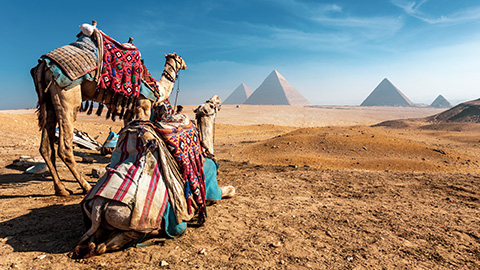
There is something truly magnificent about the Pyramids of Giza. The last remaining of the Seven Wonders of the Ancient world, the Pyramids inspire the adventurer within to take a journey in Ancient times. Transporting keen historians and tourists alike, the preserved walls and artefacts have enabled what is seen in a movie or a book come to life; envisioning what it would be like to live as the Egyptians did in the Ancient World.
For a moment, imagine coming face to face with the enormity of the Great Pyramid and comprehending how they were built by hand. The Pyramids at Giza are guarded by the lion-bodied Sphinx. It faces to the east, the direction of the rising sun.
Facts
- Age: Over 3,800 Years old
- Where: On the outskirts of Cairo, Egypt.
- Cost: Free to walk around the pyramids. There is a fee for going inside the temples.
- How tall? 146.6m, the same as a 50 Storey building.
- How much stone? 2.3 Million blocks of limestone each weighing an average of 2.5 tons.
- Why are they there? It is believed they were built as tombs to house mummified bodies of Kings Cheops, Kefren and Mykerinos.
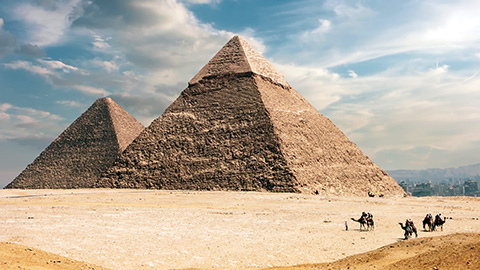
The Great Pyramid Of Khufu
The Great Pyramid of Khufu is by far the most famous Pyramid in Egypt, the biggest, tallest, and most intact. After its construction it became one of the “Seven Wonders Of The World”, and today, it is the only one of them remaining.
Khufu’s Pyramid is built entirely of limestone, and is considered an architectural masterpiece. It contains around 1,300,000 blocks ranging in weight from 2.5 tons to 15 tons and is built on a square base with sides measuring about 230m (755ft), covering 13 acres! Its four sides face the four cardinal points precisely and it has an angle of 52 degrees. The original height of the Pyramid was 146.5m (488ft), but today it is only 137m (455ft) high, the 9m (33ft) that is missing is due to the theft of the fine quality limestone covering, or casing stones, by the Ottoman Turks in the 15 Century A.D, to build houses and Mosques in Cairo.
You will find that the entrance of the Pyramid is located at the northern side, the same as almost every Pyramid in Egypt. On this side there are actually 2 entrances, one is the original, and is 17m (55ft) above ground level, and the other one is a man-made forced entrance located below it. Created in the 9th Century A.D by Khalif El-Mamoun, who was seeking the treasures that he thought might have been kept inside the Pyramid. He sent out stonemasons to open up an entrance, and they cut it midway across the centre of the northern side. Their tunnel goes almost 35m into the Pyramid, and was crudely cut, and at the end it connects with the original inner corridors of the Pyramid. Nothing was found inside, as it was plundered in antiquity. Nowadays visitors, to the site, use Mamoun’s entrance to gain access into the Pyramid, as it is actually considered to be a shortcut.
Please Note: If you attempt to go inside the Pyramid, you will have to bend down all the way till you reach the burial chamber!
From the main entrance of the Pyramid there is a long narrow corridor with low roof that descends for more than 100m (330ft), which takes you to a chamber, located about 24m (79ft) below ground level, which is an unfinished burial chamber with very little fresh air inside, and is inaccessible today.
There is also a small sign warns that it is forbidden to climb the pyramid. In the 1800's tourists climbed to the top and stood on the platform that was created when the pyramidion capstone was removed. Unfortunately several tourists have fallen to their deaths.
The Pyramid of Khafre
Khafre’s Pyramid, or the second Pyramid, is easily recognisable by the layers of its original casing stones that still remain near its summit and this, along with the fact that it actually stands on a higher part of the plateau, gives the impression that it is taller than the Great Pyramid. An optical illusion, as it is only 136m (446 ft) tall, with sides of 214.5m (704ft), a surface area of 11 acres and an angle of 53 degrees. It also has lost some of its original height through the years, once being 143.5m (471ft) tall.
The only similarity to his father’s Pyramid is the entrance in the same, north facing side. There are no corridors leading into the heart of this Pyramid, the burial chamber being underground, and a long descending passageway has to be negotiated to reach it. This entrance is 50 feet (15m) above ground level, leading to the narrow passage, which descends at a 25-degree angle into the large burial chamber, which measures 14.2m by 5m by 6.9m (46.5ft by 16.5ft by 22.5ft). To take the weight of the pyramid, the roof of the chamber is set at the same angles as the pyramid face. A large, black sarcophagus is found in this room.
A lower corridor is directly under the upper corridor, and once contained a portcullis that could be lowered to prevent entry as well as an unfinished burial chamber, which was cut from the bedrock and, it is thought, unused. Like the upper corridor, this one has a 25-degree slope, it then levels out, climbs slightly, and eventually the two of them join together. The united passageway then leads to the burial chamber.
The Pyramid of Menkaure
Khafre’s son, Menkaure, built the smallest of the three main Pyramids on the Giza Plateau. This one was only a mere 65.5m (215ft) tall, nowadays 62m (203ft), with sides of only 105m (344ft) and an angle of 51.3 degrees. It is thought that this Pyramid was altered during its construction, and made a lot bigger than originally planned. The original, smaller Pyramid had a simple descending corridor and burial chamber, but when it was enlarged, a new corridor was built with three portcullises and a small panelled chamber. Later still, another burial chamber, along with a storeroom were added at a lower level. This Pyramid, like its 2 neighbours, has a north facing entrance.
Apart from the size, Menkaure’s Pyramid differed from the other 2 in the choice of casing stones. Whereas the Pyramids of his father and grandfather were completely cased in fine, white, Turah limestone, Menkaure’s Pyramid was only partly cased in Turah limestone, from about 15m up! The first 15 metres was cased with pink granite, which had come from Aswan, the last of which was taken by Muhammad Ali Pasha (1805-1848) who used them to construct his arsenal in Alexandria.
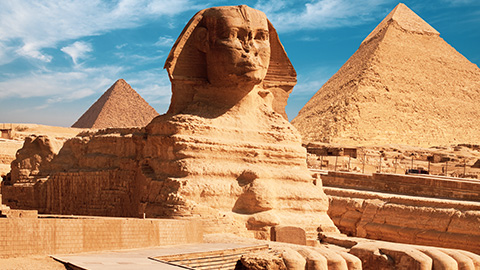
The Great Sphinx
The Great Sphinx, or as the ancients knew it, “Shesib Ankh” or “the living image”, has to be one of the most recognizable constructions in history. Think of the Sphinx and you automatically think of Egypt and the Giza Plateau.
Sculpted from limestone, many believe that it would have disappeared long ago had it not been buried in the sand for so many long periods in its lifetime. The body is 60m (200ft) long and 20m (65ft) tall. Its face is 4m (13ft) wide with eyes measuring 2m (6 ft) high. The Great Sphinx faces the east, where the sun rises and was revered so much by the ancients, that they built a temple in front of it.
The 18th Dynasty King, Thutmose IV installed a stele between its front paws, describing how, when Thutmose was a young Prince, he had gone hunting and fell asleep in the shade of the Sphinx ‘s head. Thutmose had a dream where Ra Hor-Akhty the sun God, talking through the Sphinx, spoke to him, telling the young Prince to clear away the sand because the Sphinx was choking on it. The Sphinx said to him that if he did this, he would become King of Egypt .
Thutmose cleared away all the sand and after two years, the god fulfilled his promise to the price and he was made King of Egypt.
Today, part of the “uraeus” (the sacred cobra at the forehead ), and the nose are missing (not shot off by Napoleon’s men as many believe, but were destroyed by Muhammad Sa'im Al-Dahr, a Sufi fanatic from the Khanqah of Sa'id Al-Su'ada.
In 1378, upon finding the Egyptian peasants making offerings to the Sphinx in the hope of increasing their harvest, Sa'im Al-Dahr was so outraged that he destroyed the nose!). There are parts of a beard in the Cairo and British Museum in London which reputedly belong to the Sphinx, but many Egyptologists deny this, as the style of beard found, does not relate to the “nemes” that The Sphinx wears – different Dynasties!
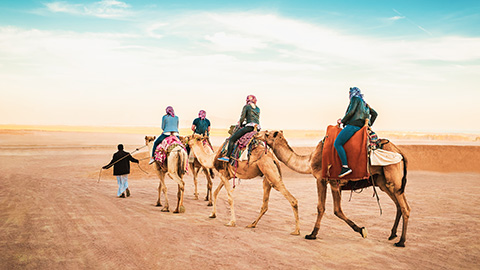
What could be more traditional than camel trekking in the Sinai? It gives the tourist the opportunity to explore nomadically, truly adopting the authentic way of exploration.
The Sinai Peninsula is triangular and lies between the Mediterranean Sea (to the north) and the Red Sea (to the south). It forms a ‘land-bridge’ from Africa to Southwest Asia. Camel trekking in this area is extremely popular and the scenery of this trek will remind you of the beginning of the earth.
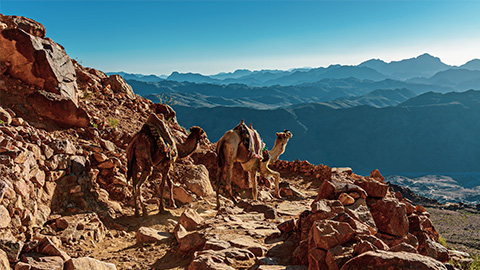
This tour leads through valleys, mountains and canyons. It is for those who want to discover this magnificent landscape and learn about the way of life of the Bedouin people. The price of this tour includes, two nights hotel in Sharm El Sheikh, six nights in tents in the Desert of the Sinai, camping equipment in the desert (tents, sleeping bags) camel transportation, all transfers (private, air-conditioned minibus, with driver), jeep transport and English speaking guide.
Itinerary Sample
Trekking Tours
All over the Sinai and in the high mountain range of St. Catherine, we offer walking tours with a Bedoiun guide. Camels are there to carry the gear.
7 Days in the High Mountains
Day 1 We drive along the beaches of the Gulf of Aqaba, where there is a possibility to swim and snorkel. Continue to the area of St. Catherine, where we stay overnight
Days 2-5 Load your luggage onto camels. Equipped with your daypack, you will trek up to the high mountains. Hike through wadis and canyons for breathtaking views of Sinai's natural wilderness. Discover orchards of apples, pears and plums, swim in natural springs and enjoy Bedoiun culture
Day 6 Visit the 5th century monastery of St. Catherine at the foot of Mount Moses. Travel to the oasis of Dahab for swimming and snorkelling in the beautiful reefs
Day 7 Hike Wadi Tmile near Nuweiba and seize the opportunity for a final swim in the crystal-clear sea before this unforgettable trip ends.
Reference
Nature Travel, (2020 11, May)

Bedouins are of Arab decent and are Nomad desert people. They live primarily in the Arabian peninsula and the Middle East and North Africa.
Few places in the desert are capable of supporting the life of even a small community for an extended period of time, and so the bedouin of the Sinai would stay on the move. With herds of sheep and goats as well as camels, the Sinai bedouin migrated from one fertile area to another–each offered sustenance and shelter for time, while the others were naturally replenished.
Bedouin Tents
A bedouin tent is customarily divided into two sections by a woven curtain known as a ma'nad. One section, reserved for the men and for the reception of most guests, is called the mag'ad, or 'sitting place.'
Welcoming guests into the tent, the Bedouins offer a drink of cardamom spiced coffee which is often replenished throughout the visit. Guests are also entertained with music, poetry and if a special occasion calls for it, dance. The bedouin have their own special instruments which they use to play their music, these include: the shabbaba, a length of metal pipe fashioned into a sort of flute and the rababa, a versatile, one-string violin. The primary singers are the bedouin women who sit in rows facing each other where they sing in a form of dialogue.
Traditional Dress
The dress of the bedouin are commonly identified with an obvious head gear and it consists of the kufiyya-cloth and 'agal' rope that constitute proper attire for a bedouin man. For the women, they are required to keep their hair covered.
FUN FACT!
The status of the bedouin is determined by the head gear. The head-rope in particular carries importance, for it is suggestive of the wearer's ability to uphold the obligations and responsibilities of manhood. While the women have their own status identified by their own head-gear and married women in particular wrap about their forehead a black cloth known as 'asaba.
Activity
Please answer the following questions about Bedouins.
References
Bedouins of Sinai Egypt, (2020, May 12) interKnowledge Corp
Bedouins, ( 2020, May 12) Facts and Details

There is no de-Nile about The Nile…
The Nile River is commonly associated with Egypt, but it flows through 11 countries and is considered one of the largest (if not the largest) river in the world flowing over 6,600 kilometers (4,100 miles)
With two main tributaries (meaning it divides into smaller rivers or streams) one is called the White Nile and the other the Blue Nile. The two rivers merge together in the city of Khartoum, Sudan. Flowing north through Egypt they meet the Mediterranean Sea.
The Nile is vitally important to people throughout history; it is essentially the source of life. For the Ancient Egyptians, it was the necessity of fresh water, food, transportation and was the provider of fertile land to farm on.
FUN FACT!
The Nile River was also an ideal growing location for the papyrus plant. Ancient Egyptians used the papyrus plant in many ways, such as making cloth, boxes, and rope, but by far its most important use was in making paper.
It is quite ironic that a river of such vitality exists within a desert dry land. However, nature enabled such existence with the flooding of the Nile every August. The flood bought with it nutrient rich soil/ silt and landing along the banks, left in it’s wake thick moist mud which provided the perfect foundation for growing crops.
Although it does not flood each year as it used to due to the building of the Aswan High Dam in 1970, it still remains a treasured source of life for the Egyptians in the modern day as it serves purpose for irrigation and trade.
It is also home to various types of wildlife including birds, as well as turtles, snakes, hippos and one of our planet’s largest reptiles the Nile crocodile.
Referencing
National Geographic. (2020, May 11). Nile River Facts.
National Geographic ( 2020, May 11). The Nile River
Based on what you have learnt about Egypt, answer the following questions.
